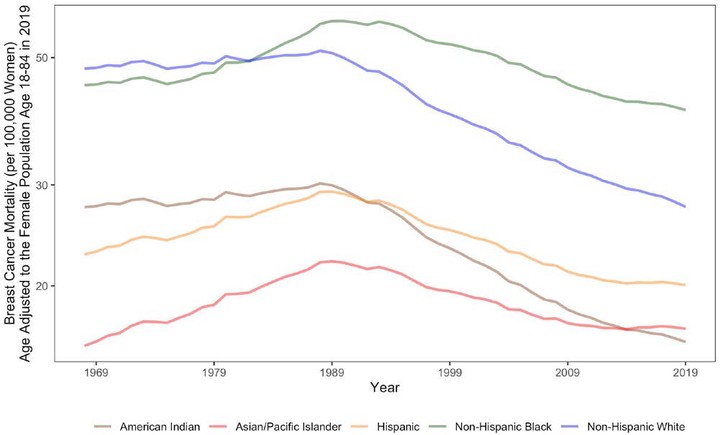Recent Changes in the Patterns of Breast Cancer as a Proportion of All Deaths by Race and Ethnicity

Abstract
Background: Recent reports suggest that racial differences in breast cancer incidence rates have decreased. We examined whether these findings apply to breast cancer mortality while considering age, period, and cohort influences on both absolute and relative measures of breast cancer mortality. Methods: Using publicly available datasets (CDC Wonder, Human Mortality Database), we developed an age-period-cohort model of breast cancer mortality and breast cancer deaths as a proportion of all deaths during 1968-2019 among all women and by five race/ethnicity groups with sufficient numbers for estimation: Hispanic (all races), American Indian/Alaska Native and Asian/Pacific Islanders (regardless of ethnicity), non-Hispanic Black, and non-Hispanic White. Results: Initially increasing after 1968, age-adjusted breast cancer mortality rates have decreased among all racial/ethnic groups since 1988. The age-adjusted percent of all deaths due to breast cancer also has been declining for non-Hispanic White women since about 1990 while increasing or holding steady for other race/ethnic groups. In 2019, the age-adjusted percent of deaths due to breast cancer for women was highest for Asian/Pacific Islanders (5.6%) followed by non-Hispanic Black (4.5%), Hispanic (4.4%), non-Hispanic White (4.1%), and American Indian/Alaska Native women (2.6%). Conclusions: Breast cancer mortality disparities are now greater on both relative and absolute scales for non-Hispanic Black women, and using the relative scale for Asian/Pacific Islanders and Hispanic women, compared with non-Hispanic White women for the first time in 50 years.